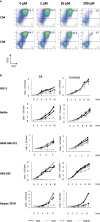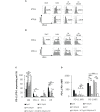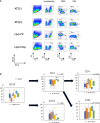Construction of the systemic anticancer immune environment in tumour-bearing humanized mouse by using liposome-encapsulated anti-programmed death ligand 1 antibody-conjugated progesterone
- PMID: 37492571
- PMCID: PMC10364058
- DOI: 10.3389/fimmu.2023.1173728
Construction of the systemic anticancer immune environment in tumour-bearing humanized mouse by using liposome-encapsulated anti-programmed death ligand 1 antibody-conjugated progesterone
Abstract
Immune checkpoint inhibitors highlight the importance of anticancer immunity. However, their clinical utility and safety are limited by the low response rates and adverse effects. We focused on progesterone (P4), a hormone produced by the placenta during pregnancy, because it has multiple biological activities related to anticancer and immune regulation effects. P4 has a reversible immune regulatory function distinct from that of the stress hormone cortisol, which may drive irreversible immune suppression that promotes T cell exhaustion and apoptosis in patients with cancer. Because the anticancer effect of P4 is induced at higher than physiological concentrations, we aimed to develop a new anticancer drug by encapsulating P4 in liposomes. In this study, we prepared liposome-encapsulated anti-programmed death ligand 1 (PD-L1) antibody-conjugated P4 (Lipo-anti-PD-L1-P4) and evaluated the effects on the growth of MDA-MB-231 cells, a PD-L1-expressing triple-negative breast cancer cell line, in vitro and in NOG-hIL-4-Tg mice transplanted with human peripheral blood mononuclear cells (humanized mice). Lipo-anti-PD-L1-P4 at physiological concentrations reduced T cell exhaustion and proliferation of MDA-MB-231 in vitro. Humanized mice bearing MDA-MB-231 cells expressing PD-L1 showed suppressed tumor growth and peripheral tissue inflammation. The proportion of B cells and CD4+ T cells decreased, whereas the proportion of CD8+ T cells increased in Lipo-anti-PD-L1-P4-administrated mice spleens and tumor-infiltrated lymphocytes. Our results suggested that Lipo-anti-PD-L1-P4 establishes a systemic anticancer immune environment with minimal toxicity. Thus, the use of P4 as an anticancer drug may represent a new strategy for cancer treatment.
Keywords: breast cancer; humanized mouse; immune environment; liposome; progesterone; programmed death ligand 1.
Copyright © 2023 Kametani, Ito, Ohshima, Manabe, Ohno, Shimizu, Yamada, Katano, Kirigaya, Ito, Matsumoto, Tsuda, Kashiwagi, Goto, Yasuda, Maeki, Tokeshi, Seki, Fukase, Mikami, Ando, Ishimoto and Shiina.
Conflict of interest statement
The authors declare that the research was conducted in the absence of any commercial or financial relationships that could be construed as a potential conflict of interest.
Figures







Similar articles
-
Liposome-encapsulated progesterone efficiently suppresses B-lineage cell proliferation.Biochem Biophys Rep. 2024 Apr 11;38:101710. doi: 10.1016/j.bbrep.2024.101710. eCollection 2024 Jul. Biochem Biophys Rep. 2024. PMID: 38638674 Free PMC article.
-
Liposome Nanomedicine Based on Tumor Cell Lysate Mitigates the Progression of Lynch Syndrome-Associated Colon Cancer.ACS Biomater Sci Eng. 2024 May 13;10(5):3136-3147. doi: 10.1021/acsbiomaterials.3c01531. Epub 2024 Apr 25. ACS Biomater Sci Eng. 2024. PMID: 38663028
-
Disruption of SIRT7 Increases the Efficacy of Checkpoint Inhibitor via MEF2D Regulation of Programmed Cell Death 1 Ligand 1 in Hepatocellular Carcinoma Cells.Gastroenterology. 2020 Feb;158(3):664-678.e24. doi: 10.1053/j.gastro.2019.10.025. Epub 2019 Oct 31. Gastroenterology. 2020. PMID: 31678303
-
Immune Checkpoint Blockade in Cancer Immunotherapy: Mechanisms, Clinical Outcomes, and Safety Profiles of PD-1/PD-L1 Inhibitors.Arch Immunol Ther Exp (Warsz). 2020 Nov 13;68(6):36. doi: 10.1007/s00005-020-00601-6. Arch Immunol Ther Exp (Warsz). 2020. PMID: 33185750 Review.
-
Prospective role of PD-1/PD-L1 immune checkpoint inhibitors in GI cancer.Pathol Res Pract. 2023 Apr;244:154338. doi: 10.1016/j.prp.2023.154338. Epub 2023 Jan 23. Pathol Res Pract. 2023. PMID: 36905697 Review.
Cited by
-
Progesterone boosts abiraterone-driven target and NK cell therapies against glioblastoma.J Exp Clin Cancer Res. 2024 Aug 6;43(1):218. doi: 10.1186/s13046-024-03144-2. J Exp Clin Cancer Res. 2024. PMID: 39103871 Free PMC article.
-
Liposome-encapsulated progesterone efficiently suppresses B-lineage cell proliferation.Biochem Biophys Rep. 2024 Apr 11;38:101710. doi: 10.1016/j.bbrep.2024.101710. eCollection 2024 Jul. Biochem Biophys Rep. 2024. PMID: 38638674 Free PMC article.
-
PBMC-engrafted humanized mice models for evaluating immune-related and anticancer drug delivery systems.Front Mol Biosci. 2024 Aug 20;11:1447315. doi: 10.3389/fmolb.2024.1447315. eCollection 2024. Front Mol Biosci. 2024. PMID: 39228913 Free PMC article. Review.
References
Publication types
MeSH terms
Substances
LinkOut - more resources
Full Text Sources
Other Literature Sources
Medical
Research Materials
Miscellaneous

